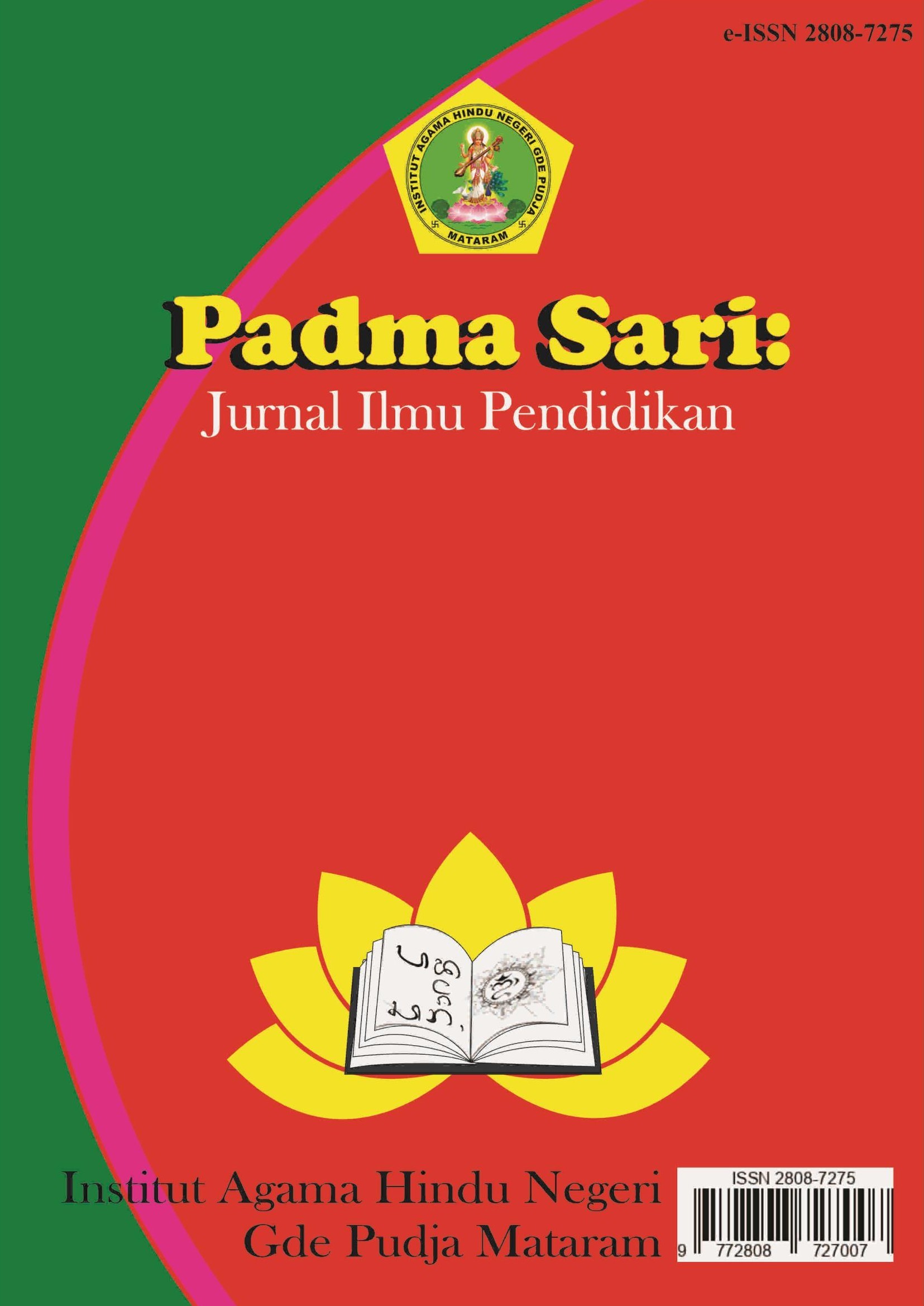PENDIDIKAN KARAKTER MELALUI PROSESI PERKAWINAN HINDU
Abstract
This study aims to describe the pattern of character education that can be internalized from Hindu marriage ceremonies. This is also based on the idea that educational interaction has the function of helping the development of all potential, skills and characteristics of students, both in terms of intellectual, social, affective, and psychomotor aspects. Religious education will grow and increase sraddha and bhakti to Brahman through giving, cultivating, understanding and experiencing teachings. In addition to education, both formal, informal and non-formal, character education can also be explored through a wedding procession (pawiwahan). This research uses an qualitative approach with data collection through observation, interviews and documentation studies. The data obtained is then analyzed through a series of data reduction processes, data display and conclusions. The results of the study indicate that through the pawiwahan procession, or called dharmika, it is hoped that Hindus who go through the pawiwahan process are able to realize the noble ideals of Moksartham Jagadhita ya ca iti dharma. In Hindu education, strive for the birth of people who are Pradnyan and Purusottama. Pradnyan is interpreted as a condition of Hindu humans who should have competencies that are in accordance with the field of knowledge they are engaged in (according to swadharma). The value of education in Hindu pawiwahan also cannot be separated from the three basic frameworks of Hinduism, namely Tattwa, Susila and Upacara. The value of character education is explored through the philosophy of the various means used in pawiwahan, each of which has a very deep meaning, and this is believed to provide provisions for the formation of brides who have sadhu Gunawan characteristics.
References
Ali, M. 1992. Guru dalam proses belajar menagajar
Bandung :Sinar Baru
Atmadja dkk, 2017. Agama Hindu, Panca sila dan kearifan lokal Fondasi Pendidikan Karakter. Denpasar : Pustaka laksana
Dantes I N. 1999. Teori-teori Belajar, Teori-teori intruksional dan Model-model Pembelajaran, Singaraja: STKIP Negeri Singaraja
Derson, D., Dharmawan, I. G., & Edung, T. (2021). UPACARA BOKAS PADA ACARA PERKAWINAN UMAT HINDU KAHARINGAN DAYAK DUSUN (KAJIAN PENDIDIKAN AGAMA HINDU). Padma Sari: Jurnal Ilmu Pendidikan, 1(01), 28-37. https://doi.org/https://doi.org/10.53977/ps.v1i01.348
Depdiknas. 2003. Kurikulum bersasis Komptensi. Standar Kompetensi Mata Pelajaran Pendidikan Agama Hindu Sekolah Menengah Atas. Jakarta.Departemen Pendidikan Nasional.
Gunada, I. W. A., Pramana, I. B. K. Y., & Rudiarta, I. W. (2021). PENGUATAN PENDIDIKAN KARAKTER HINDU DALAM YOGA UNTUK SISYA PASRAMAN AMERTA SANJIWANI. Jurnal Lektur Keagamaan, 19(2), 311-346.
Gunarta, I M. 2014. Kearifan Bali Bicara Melalui Tindakan, Gianyar : Yayasan Krtasta Guna.
Himpunan Keputusan Seminar Kesatuan Tafsir Terhadap Aspek-Aspek Agama Hindu I-XV. 2000. Tingkat I Bali.
Kajeng, I N. dkk. 1997. Sarasamuccaya Dengan Teks Bahasa Sansekerta dan Jawa Kuna. Jakarta: Paramita.
Nala, I G N dan Atmadja, I G.K. Adia, 2012, Murdha Agama Hindu, Program Bimbingan Masyarakat Hindu, Upada Sastra.
Poerwadarminta, WJS. 1986. Kamus Umun Bahasa Indonesia. Jakarta : Pengembangan dan Pembinaan Bahasa Bali.
Pudja dkk, G. 2010. Manava Dharmasastra Atau Weda Smerti. Surabaya : Paramita
Saputra, R., & Fitriani, E. (2019). Nilai Pendidikan Karakter Pada Upacara Panggih Temanten Pada Masyarakat Jawa Silaut. Jurnal Perspektif, 2(1), 34-40.
Subrata, I. N. (2019). Ajaran catur asrama persepektif konsepsi hidup untuk mencapai tujuan hidup. Sphatika: Jurnal Teologi, 10(1), 72-81.
Sukmadinata, Nana Syodih, 2004. Landasan Psikologi Proses Pendidikan. Bandung : PT Remaja Rosdakarya.
Titib, I M. 1995. Ketuahan Dalam Veda. Denpasar : Manikgeni.
Tri Guna, I B G Y. 2017. Budaya Inspiratif & Pembangunan Karakter. Pasca Sarjana Universitas Hindu Indonesia.
Wiana, I K. 1998. Berbhakti Pada Leluhur. Denpasar :Paramita
Wiana, I K. 2012. Mengapa Bali disebut Bali ?. Denpasar: Paramita

This work is licensed under a Creative Commons Attribution 4.0 International License.




















